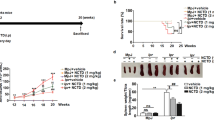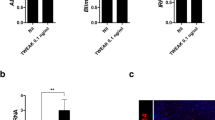Summary
In MRL-lpr/lpr (MRL/1) mice developing the SLE-like autoimmune disorder, PQQ can modulate many features of the pathological process including immune functions. The mean survival time was extended; enlargements of lymphoid organs and also of the liver were reduced; titres of anti-double stranded (ds) DNA antibodies and concentrations of serum amyloid P component (SAP) were reduced; serum IgG levels were not changed; T cell mitogenic responses to concanavalin A (con A) were enhanced, whereas B cells stimulated with lipopolysaccharide (LPS) were not. The results suggest that PQQ partly inhibits the development of the SLE-like disease in MRL/1 mice, probably by reducing inflammation and influencing T cell differentiation.
Access this chapter
Tax calculation will be finalised at checkout
Purchases are for personal use only
Preview
Unable to display preview. Download preview PDF.
Similar content being viewed by others
References
Buttke, T. M., and Sandstrom, P. A. (1994) Oxidative stress as a mediator of apoptosis. Immunol Today 15: 7–10.
Cohen, P. L., and Eisenberg, R. A. (1991) Lpr and gld: Single gene models of systemic autoimmunity and lymphoproliferative disease. Ann. Rev. Immunol. 9: 243–269.
Flückiger, R., Paz, M. A., Henson, E., Gallop, P. M., and Bergethon, P. R. (1992) Glycine-dependent redox cycling and other methods for PQQ and quinoprotein detection. In: V. L. Davidson (ed.): Principles and application of quinoproteins, Marcel Dekker Inc, New York, pp 331–341.
Gutierrez-Ramos, J. C., Andreu, J. L., Revilla, Y., Vinuela, E., and Martinez, C. (1990) Revovery from autoimmuninity of MLR/Ipr mice after infection with an interleukin-2/vaccinia recombinant virus. Nature 346: 271–274.
Hamagishi, Y., Murata, S., Kamei, H., Oki, T., Adachi, O., and Ameyama, M. (1990) New biological properties of pyrroloquinoline quinone and its related compounds: Inhibition of chemiluminescence, lipid peroxidation and rat paw edema. J. Pharmacol. Exp. Ther. 255: 980–985.
Killgore, J., Smidt, C., Duich, L., Romero-Chapman, N., Tinker, D., Reiser, K., Melko, M., Hyde, D., and Rucker, R. B. (1989) Nutritional importance of pyrroloquinoline quinone. Science 245: 850–852.
Meyer, M., Schreck, R. and Baeuerle, P. A. (1993) H2O2 and antioxidants have opposite effects on activation of NF-KB and AP-I in intact cells: AP-1 as secondary antioxidant-responsive factor. EMBO J.: 2005–2015.
Mountz, J. D., Zhou, T., Eldridge, J., Berry, K., and Blüthmann, H. (1990) Transgenic rearranged T cell receptor gene inhibits lymphadenopathy and accumulation of CD4–CD81B220+ T cells in 1pr/Ipr mice. J. Exp. Med. 172: 1805–1817.
Robey, F. A., Jones, K. D., Tanaka, T., and Liu, T. Y. (1984) Binding of c-reactive protein to chromatin and nucleosome core particles A possible physiological role of C-reactive protein. J. Biol. Chem. 259: 7311–7316.
Spetz-Hagberg, A. L., Goldschmidt, T. J., Stalhandske, T., and Larsson-Sciard, E. L. (1990) Amelioration of intrathymic T cell development and peripheral T cell reactivities in autoimmune mice undergoing therapy with a novel immunomodulator. Int. Immunol. 2: 645–650.
Tilg, H., Vannier, E., Vachino, G., Dinarello, C. A., and Mier, J. W. (1993) Anti inflammatory properties of hepatic acute phase proteins: Preferential induction of interleukin 1 (IL-1) receptor antagonist over IL-lß synthesis by human peripheral blood mononuclear cells. J. Exp. Med. 178: 1629–1636.
Xu, F., Mack, C. P., Quandt, K. S., Shlafer, M., Massey, V., and Hultquist, D. E. (1993) Pyrroloquinoline quinone acts with flavin reductase to reduce ferryl myoglobin in vitro and protects isolated heart from re-oxygenation injury. Biochem. Biophys. Res. Commun. 193: 434–439.
Author information
Authors and Affiliations
Editor information
Editors and Affiliations
Rights and permissions
Copyright information
© 1994 Birkhäuser Verlag Basel/Switzerland
About this paper
Cite this paper
Weimann, B.J. (1994). Effect of pyrroloquinoline quinone (PQQ) on the SLE-like (Systemic Lupus Erythematosus) disease in MRL-Ipr/Ipr mice. In: Marino, G., Sannia, G., Bossa, F. (eds) Biochemistry of Vitamin B6 and PQQ. Advances in Life Sciences. Birkhäuser Basel. https://doi.org/10.1007/978-3-0348-7393-2_56
Download citation
DOI: https://doi.org/10.1007/978-3-0348-7393-2_56
Publisher Name: Birkhäuser Basel
Print ISBN: 978-3-0348-7395-6
Online ISBN: 978-3-0348-7393-2
eBook Packages: Springer Book Archive




